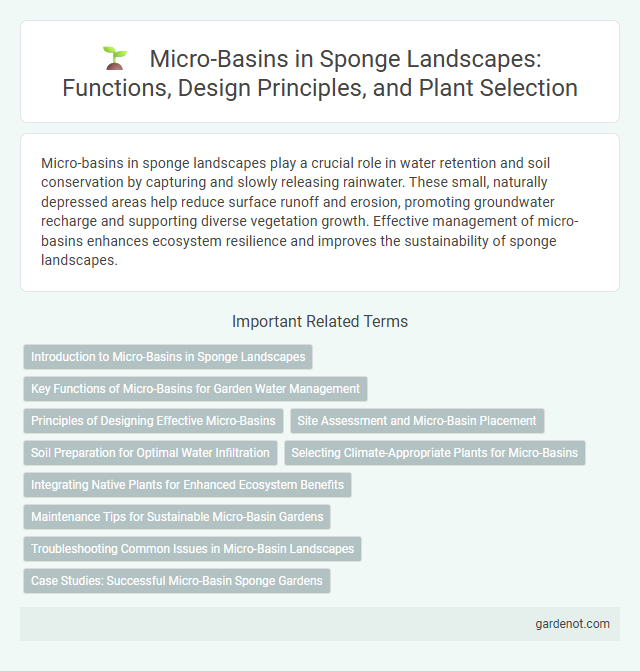Micro-basins in sponge landscapes play a crucial role in water retention and soil conservation by capturing and slowly releasing rainwater. These small, naturally depressed areas help reduce surface runoff and erosion, promoting groundwater recharge and supporting diverse vegetation growth. Effective management of micro-basins enhances ecosystem resilience and improves the sustainability of sponge landscapes.
Introduction to Micro-Basins in Sponge Landscapes
Micro-basins in sponge landscapes act as natural water retention systems that capture and store rainfall, enhancing groundwater recharge and reducing surface runoff. These small-scale catchments, typically characterized by permeable soil and dense vegetation, help mitigate soil erosion and improve water quality by filtering sediments and pollutants. Their strategic design and distribution optimize landscape hydrology, supporting ecosystem resilience and sustainable water management.
Key Functions of Micro-Basins for Garden Water Management
Micro-basins play a crucial role in garden water management by capturing and infiltrating rainwater, reducing surface runoff and erosion. They enhance soil moisture retention, supporting healthy plant growth and reducing the need for supplemental irrigation. These micro-scale water catchments also promote groundwater recharge, contributing to sustainable water cycles within urban landscapes.
Principles of Designing Effective Micro-Basins
Effective micro-basin design integrates contour trenching, vegetation cover, and controlled runoff management to maximize water infiltration and prevent soil erosion. Incorporating natural topography and soil permeability ensures optimal water retention while supporting local biodiversity. Strategic placement of swales and check dams enhances sediment capture and sustains micro-habitats within sponge landscapes.
Site Assessment and Micro-Basin Placement
Micro-basin site assessment involves analyzing soil type, slope gradient, and rainfall patterns to optimize water retention and reduce runoff effectively. Proper micro-basin placement ensures maximum infiltration by situating basins along contour lines where water naturally accumulates. Integrating geospatial data and hydrological modeling enhances precision in micro-basin configuration for sustainable landscape management.
Soil Preparation for Optimal Water Infiltration
Micro-basins enhance water infiltration by creating small, shallow depressions that slow runoff and promote soil absorption. Soil preparation involves loosening compacted layers and incorporating organic matter to improve porosity and water retention. Properly prepared soil in micro-basins significantly reduces erosion while maximizing groundwater recharge.
Selecting Climate-Appropriate Plants for Micro-Basins
Selecting climate-appropriate plants for micro-basins enhances water retention and soil stabilization critical to sponge landscape effectiveness. Native drought-resistant species, such as vetiver grass and succulents, are ideal for arid regions, improving infiltration and reducing erosion. In humid climates, deep-rooted plants like willows and sedges support runoff absorption and sustain groundwater recharge.
Integrating Native Plants for Enhanced Ecosystem Benefits
Micro-basins designed with native plants significantly improve water retention and reduce soil erosion by leveraging deep root systems adapted to local conditions. Integrating indigenous vegetation enhances biodiversity, supports pollinators, and promotes a balanced micro-ecosystem within the sponge landscape framework. These native species also increase resilience to drought and flooding, optimizing natural water filtration and storage capacities essential for sustainable watershed management.
Maintenance Tips for Sustainable Micro-Basin Gardens
Regularly removing accumulated debris and sediment from micro-basin edges enhances water retention and prevents overflow, ensuring effective rainwater harvesting. Incorporating native plants with deep root systems stabilizes soil and reduces erosion, supporting long-term micro-basin sustainability. Periodic inspections for cracks or structural damage allow timely repairs, maintaining optimal functionality in micro-basin gardens.
Troubleshooting Common Issues in Micro-Basin Landscapes
Micro-basin landscapes often face drainage inefficiencies caused by soil compaction, which reduces infiltration rates and increases surface runoff. Addressing sediment buildup through regular maintenance helps prevent blockages that disrupt water retention and promote erosion. Implementing vegetation with deep root systems enhances soil structure, improving water absorption and stability in these micro-catchments.
Case Studies: Successful Micro-Basin Sponge Gardens
Successful micro-basin sponge gardens demonstrate significant improvements in water retention, soil moisture conservation, and biodiversity enhancement in semi-arid regions. Case studies from Andhra Pradesh, India, reveal that integrating contour trenches and native vegetation within micro-basins reduces runoff by up to 40%, promoting groundwater recharge and sustainable agriculture. These projects exemplify effective landscape sponge principles, showcasing scalable solutions for climate adaptation and ecosystem restoration.
Micro-basin Infographic

 gardenot.com
gardenot.com